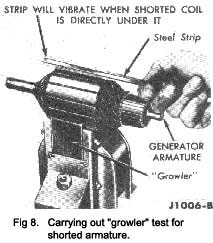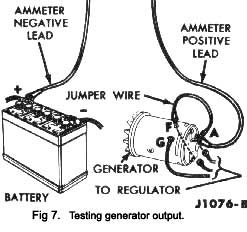3. Refit the field and earth terminal screws, washers and nuts in the frame.
4. Refit the brush arms and springs and insert new brushes in their brush holders and seat them as previously described.
5. Move the brushes back in their holders until the springs ride against the side of the brushes so as to retain them in the relieved position.
6. Refit the bearing in the front end-plate and secure with the bearing retainer.
7. Slide the plate on to the armature shaft, with the retainer towards the armature windings, and fit the woodruff key, pulley, locking washers and retaining nut.
8. Refit the armature and front end-plate assembly in the frame, locating the dowel in the frame groove.
9. Refit the brush end-plate, aligning the locating boss and frame groove, and install the through ‘ bolts with locking washers and nuts.
10. Using a strand of stout wire formed with a hooked end, position the brush springs on top of the brushes ~o as to retain them in contact with the commutator.
TESTING THE GENERATOR
Generator output test (Refer to Fig. 7)
When a generator output test is conducted off the car, a generator-regulator test bench must be used. In this instance, the generator is placed on the test bench and driven by a motor. Follow the procedure given by the manufacturer.
|
To test the output of the generator on the vehicle, proceed in the following manner. Disconnect the regulator armature and field wires at the generator. Connect a “Jumper “ wire from the generator armature terminal to the generator field terminal. Start the engine and, whilst it is idling, connect the ammeter negative lead to the positive terminal of the battery.
Run the engine at 1500 r.p.m., and read the current output on the ammeter. The generator should read or exceed its rated output.
Note——Disconnect the test leads as soon as the test is completed to prevent overheating the generator and then stop the engine.
Testing the armature (Refer to Fig. 8 and 9)
To check the armature for open, short, or grounded circuits, the generator must be removed from the car.
Open circuit test:
An open circuit in the armature can sometimes be detected by examining the commutator for evidence of bad burning. A badly burned spot on the commutator is caused by an arc formed every time the commutatcr segment connected to open circuit, passes under a brush.
Short circuit test:
To test the armature for a short circuit in the windings, a “growler” must be used, as shown in Fig. 8. Rotate the armature slowly and when the shorted winding is under the steel strip, it will cause the strip to vibrate.

|
 **
**

